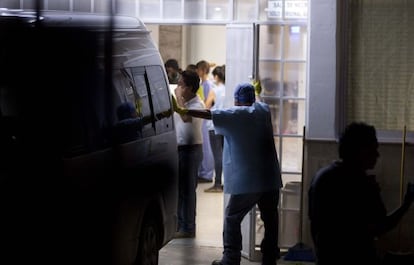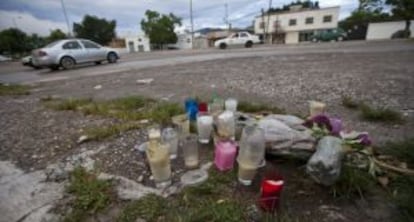Mexican president sends new security force to take over Iguala
Town where 43 students were arrested and killed is under control of a local drug gang


From now on, a new town’s name will be forever linked to the acts of barbaric violence taking place across Mexico.
Iguala, located in the heart of Guerrero state, is where 43 students enrolled at a teachers’ college disappeared on the night of September 26, after being arrested by local police.
At least 17 of them were killed by two hitmen after the authorities turned the detainees over to them. A mass grave found outside the town was found to contain 28 burned bodies whose identities have yet to be confirmed.
The killers’ confession, made public by the state prosecutor, has shaken the country and underscored how organized crime wields almost unlimited power in some parts of the country.
President Enrique Peña Nieto sought to send out the message that his government would leave “not the slightest wiggle room for impunity” and described the violence against the young students as “infuriating, painful and unacceptable.”
In a show of strength, Peña Nieto said that federal authorities would participate in the investigation and that the Gendarmería, the new swift response unit set up to combat the drug trade, has been dispatched to take control of Iguala. The director of the Criminal Investigation Agency, Tomás Zerón – the man who captured drug lord El Chapo Guzmán – has also been sent down to Iguala with orders to clear up what happened as soon as possible.
“We will not allow any criminal group to impose its will,” said Attorney General Jesús Murillo Karam, who is now in charge of most of the investigation.
Meanwhile, colleagues of the victims are announcing “radical actions” to protest the deaths and disappearances, and the possibility of the violence escalating further grows by the hour, especially if more bodies are found.
In Iguala, at least 30 local officers belong to the drug organization Guerreros Unidos
Authorities know that only part of the puzzle has emerged so far: the hitmen did not explain why the mass grave contained 28 bodies instead of the 17 they claimed to have killed, nor did they clear up where the other missing students went.
But the partial reconstruction of events by investigators shows the collusion between local authorities and the cartel known as Guerreros Unidos.
It began when the students attended a protest during a public event attended by the mayor’s wife and attempted to take over three buses; the gang’s hitmen provided backup for the police, who began firing indiscriminately against the protestors.
Local authorities arrested 43 students, who were marched to the police courtyard and handed over to the criminal group. Their crime: having rebelled against the power of the drug lords. One by one they were killed in the uninhabited district of Pueblo Viejo. The bodies were then piled up and set alight using firewood and diesel oil. Some of the victims, who were all between 18 and 23 years old, may have been mutilated before that.

The order to kidnap the students was given by local police chief Francisco Salgado Valladares, while the order to kill them came from a local mafia boss known as El Chuky – two sides of the same coin.
The hitmen’s confession rules out the possibility that the students were hiding out in the mountains to avoid repression. The cold-blooded murders illustrate the tactics of Mexico’s drug gangs, in this case the Guerreros Unidos, a group that rose out of the ashes of the Beltrán Leyva empire after its leader, Arturo Beltrán Leyva, the Boss of Bosses, was shot to death in December 2009.
In just a few years, the cartel has made extensive headway in Mexico and Guerrero states, where it has gained control of entire cities. Such is the case with Iguala, population 130,000, where the state prosecutor admits that the municipal police is at the gang’s service: at least 30 local officers, according to the arrested hitmen, belong to Guerreros Unidos.
The hitmen’s confession rules out the possibility that the students might be hiding out in the mountains
While investigators try to locate the masterminds behind the crime, the two main suspects – the city mayor and his security chief – have vanished. The day after the bloodletting, Mayor José Luis Abarca cynically stated: “I didn’t hear anything.” The local leader is not only believed to have ties to the drug trade, but is also thought to have physically eliminated three leaders of an opposition party, who were kidnapped and shot dead in May 2013.
All of the deceased students were enrolled in the Escuela Normal Rural Raúl Isidro Burgos teachers’ college in Ayotzipan, a town located 123 kilometers from Iguala. Students at the college are referred to as “normalistas” and for decades have been part of a very militant community.
On Friday, September 25, they had gone to Iguala to raise funds for their activities. At nightfall they went to the bus depot and took over three vehicles, a regular practice to which the transport companies give their consent to prevent greater damage.
The clashes with the police began outside the station, resulting in six deaths and 17 injured. Then came the arrests and executions.
Tu suscripción se está usando en otro dispositivo
¿Quieres añadir otro usuario a tu suscripción?
Si continúas leyendo en este dispositivo, no se podrá leer en el otro.
FlechaTu suscripción se está usando en otro dispositivo y solo puedes acceder a EL PAÍS desde un dispositivo a la vez.
Si quieres compartir tu cuenta, cambia tu suscripción a la modalidad Premium, así podrás añadir otro usuario. Cada uno accederá con su propia cuenta de email, lo que os permitirá personalizar vuestra experiencia en EL PAÍS.
En el caso de no saber quién está usando tu cuenta, te recomendamos cambiar tu contraseña aquí.
Si decides continuar compartiendo tu cuenta, este mensaje se mostrará en tu dispositivo y en el de la otra persona que está usando tu cuenta de forma indefinida, afectando a tu experiencia de lectura. Puedes consultar aquí los términos y condiciones de la suscripción digital.








































